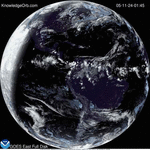
Hubble Space Telescope images reveals the breakup of an asteroid over a period of several months starting in late 2013
Credit: NASA, ESA, and D. Jewitt (University of California, Los Angeles)
NASA – The Hubble Space Telescope has photographed the never-before-seen breakup of an asteroid into as many as 10 smaller pieces.
Though fragile comet nuclei have been seen falling apart as they near the Sun, nothing like this breakup has ever before been observed in the asteroid belt.
“This is a rock. Seeing it fall apart before our eyes is pretty amazing,” said David Jewitt of UCLA, who led the astronomical forensics investigation.
The crumbling asteroid, designated P/2013 R3, was first noticed as an anomalous, fuzzy-looking object on Sept. 15, 2013, by the Catalina and Pan-STARRS sky surveys. A follow-up observation on October 1 with the W. M. Keck Observatory on the summit of Mauna Kea, Hawaii revealed three co-moving bodies embedded in a dusty envelope that is nearly the diameter of Earth.
“Keck showed us that this thing was worth looking at with Hubble,” Jewitt said. With its superior resolution, Hubble observations soon showed that there were really 10 embedded objects, each with comet-like dust tails. The four largest rocky fragments are up to 200 yards in radius, about twice the length of a football field.
Replated: Comet ISON most likely destroyed by the Sun
The Hubble data showed that the fragments are drifting away from each other at a leisurely one mile per hour — slower than the speed of a strolling human. The asteroid began coming apart early last year, but new pieces continue to emerge in the most recent images.
This makes it unlikely that the asteroid is disintegrating because of a collision with another asteroid, which would be instantaneous and violent by comparison to what has been observed. Some of the debris from such a high-velocity smashup would also be expected to travel much faster than observed.
Nor is the asteroid coming unglued due to the pressure of interior ices warming and vaporizing. The asteroid is too cold for ices to significantly sublimate, and it has presumably maintained its nearly 300-million-mile distance from the Sun for much of the age of the solar system.
This leaves a scenario in which the asteroid is disintegrating due to a subtle effect of sunlight, which causes the rotation rate to slowly increase. Eventually, its component pieces, like grapes on a stem, gently pull apart due to centrifugal force. The possibility of disruption by this so-called YORP torque has been discussed by scientists for several years but, so far, never reliably observed.
For this to happen, P/2013 R3 must have a weak, fractured interior, probably as the result of numerous, ancient, non-destructive collisions with other asteroids. Most small asteroids, in fact, are thought to have been severely damaged in this way, giving them a “rubble pile” internal structure. P/2013 R3 itself is probably the product of collisional shattering of a bigger body some time in the last billion years.
With the previous discovery of an active asteroid spouting six tails (P/2013 P5), astronomers are seeing more circumstantial evidence that the pressure of sunlight may be the primary force that disintegrates small asteroids (less than a mile across) in the solar system.
The asteroid’s remnant debris, weighing in at 200,000 tons, will in the future provide a rich source of meteoroids. Most will eventually plunge into the Sun but a small fraction of the debris may one day hit the Earth to blaze across the sky as meteors.







